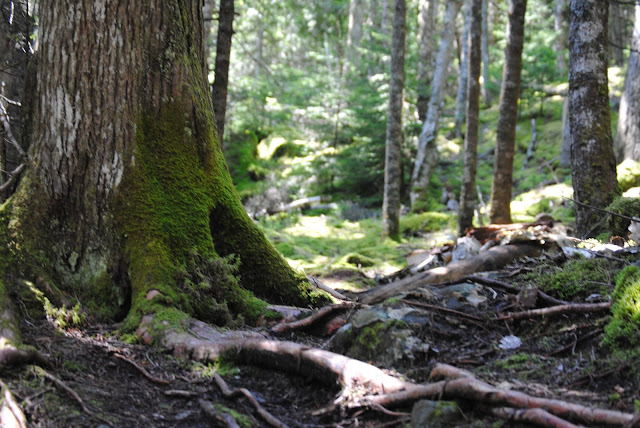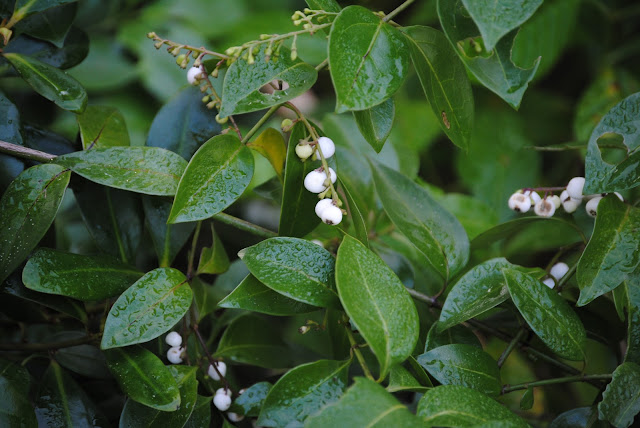 |
| photo by Olivia Scott |
Up early to see a beautiful December sunrise and to get ready for a great outing in nature. This is a boat trip to Thornton Key Preserve and a botanical nature walk led by Dr Bill Dunson, Phd.. The trip was sponsored by the Charlotte Harbor Sierra club.
Thornton Key is a small barrier island in along the intracoastal waterway of Lemon Bay.
Phil Dakin, generously provided a very comfortable pontoon boat for the ride from Placida to Thornton Key.
On the way, we saw American White Pelicans resting on a sandbar with some smaller Brown Pelicans and Laughing Gulls.
There is no land access to the preserve, but there is a nice dock for boats and a small pull-out for kayakers.
The 31 acres of the preserve has several interesting ecological habitats: tropical hardwood hammock , mangrove swamp, salt barrens, and herbaceous marsh.
An improved trail circles the preserve and the county has made recent efforts to remove invasive species like Brazilian Pepper Plants and Australian Pines.
Retired professor, Dr Bill, proved not to really be retired....as he taught a class on local botany as the group moved along the trail.
We must have learned about a hundred plant species, but I will show you the few that I remember! Above are some seed pods of a Knicker Bean Plant (Caesalpinia bonduc), a thorny, climbing bush....and the main food source of the rare Miami Blue butterfly.
If you are interested, you can contact Dr Bill through the Lemon Bay Conservancy. http://www.lemonbayconservancy.org/ I am sure he will provide you with an extensive, and somewhat intimidating plant list. Better yet, sign up for a future outing with Dr Bill through the conservancy website.
Shoestring Ferns (Vittaria lineata) were found near a wet area. Similar to Bromeliads, it is an air plant and grows only on Sabal Palms.
When the sun warmed things up, we saw a few butterflies. Here is a Gulf Fritillary (Agraulis vanillae).
Down the path was a Gulf Fritillary caterpillar (or instar), feeding on a Corky Stem Passionflower vine (Passiflora suberosa).
Dr Bill shared his knowledge about disturbed areas, micro habitats and successional regrowth patterns. Awareness of these things make a "walk in the woods" much more exciting.
We all decided this would be the "plant of the day," following Dr Bill's advice to just learn "one new one." The pleasant aroma from this Saffron Plum (Sideroxylan celastrinum) drew our interest, and it also did to lots of bees and other pollinators.
Sierra Clubber, Allain Hale, gets some one on one instruction about leaf structure.
This Snowberry (Chiococca alba) does well in dry conditions, and sure enough, we found it up on the hammock where it's waxy leaves were collecting some morning dew.
A class outside, in nature, is much more meaningful than one heard in a lecture hall. But, if you like to read, here's a link to a free e-book on Botany
Christmas Berry Bush (Lycium carolinanum) which does well in a salty soil....found near the mangroves.
Phil and Allain looking for telltale black spots on the edges of a Black Mangrove leaf. The photo below shows perhaps the most interesting and unusual feature on the Key....a salt flat with a stunted Black Mangrove (Avicennia germinens) forest.
The salt flat floods and dries periodically, leaving the soil unusually saline....much more than Black Mangrove trees are used to.....as they normally grow a bit away from the shore.....so, they have become stunted. An interesting observation and a lesson in micro-habitats.
After our walk, Captain Phil piloted boat and passengers in a stately fashion to the Rum Bay Restaurant, across the intercoastal on Manasota Key.
The group enjoyed some great food and had a chance to get to know one another, share their thoughts on the day, and make plans for future outings.
The short ride from lunch back to the marina brought us a close-up view of a wintering Common Loon (Gavia immer).
On his first outing with the Sierra Club, Rick Kirkwood takes in the view on the way home. I'll bet he'll be back for a another outing.....and if you are in the area, why don't you check out the group schedules and join us.
Interested in Conservation Biology? You can pick up a good used copy on Amazon.com for a very reasonable price.


























































